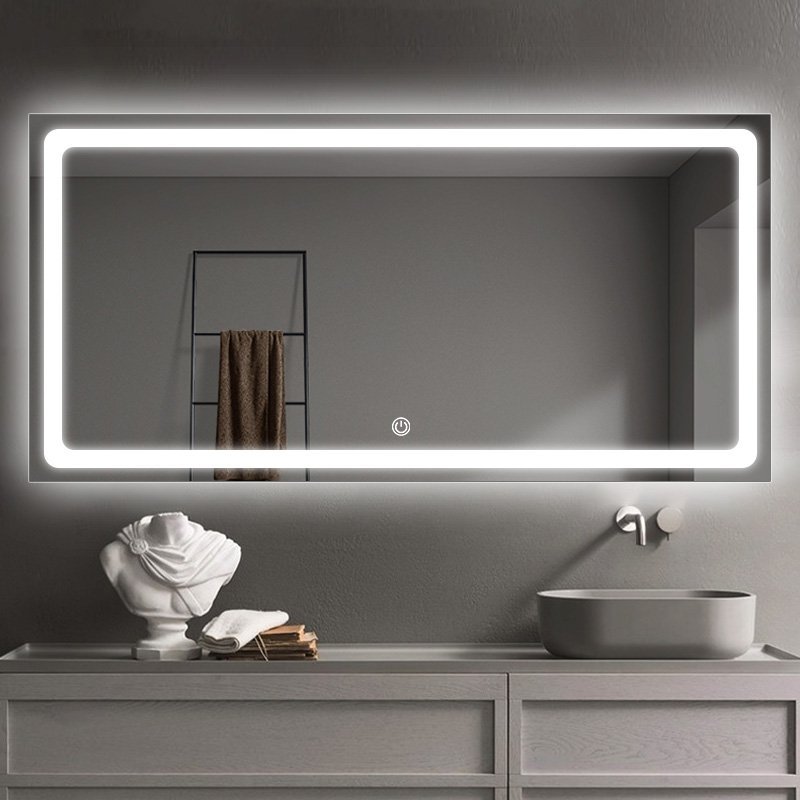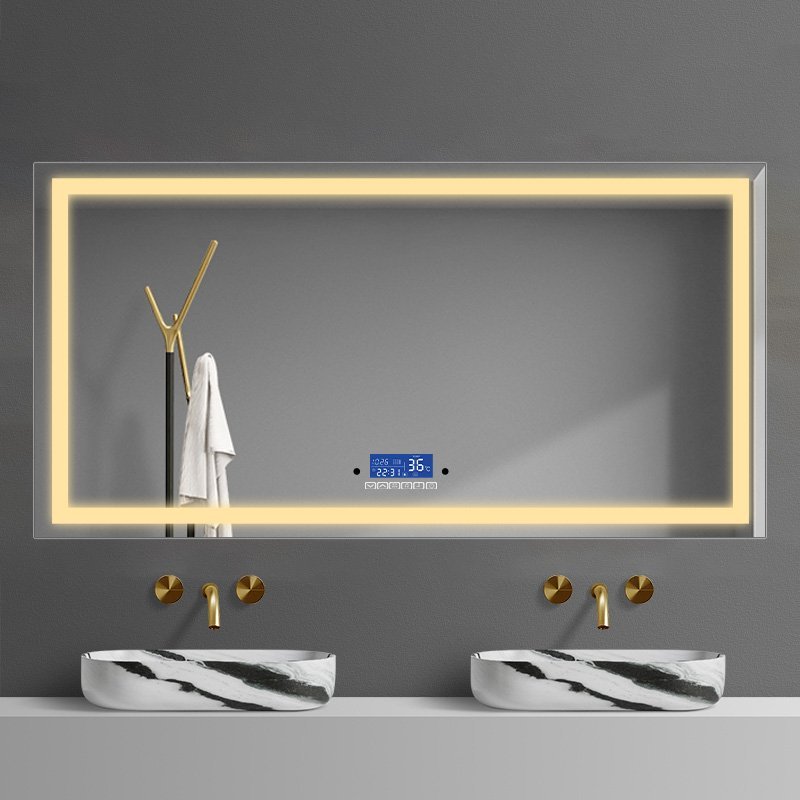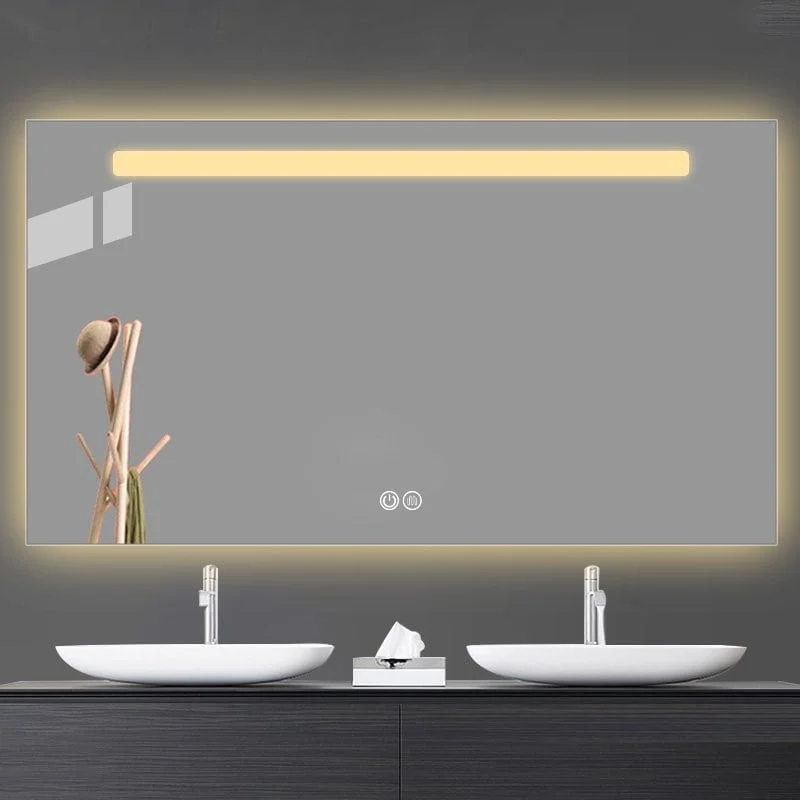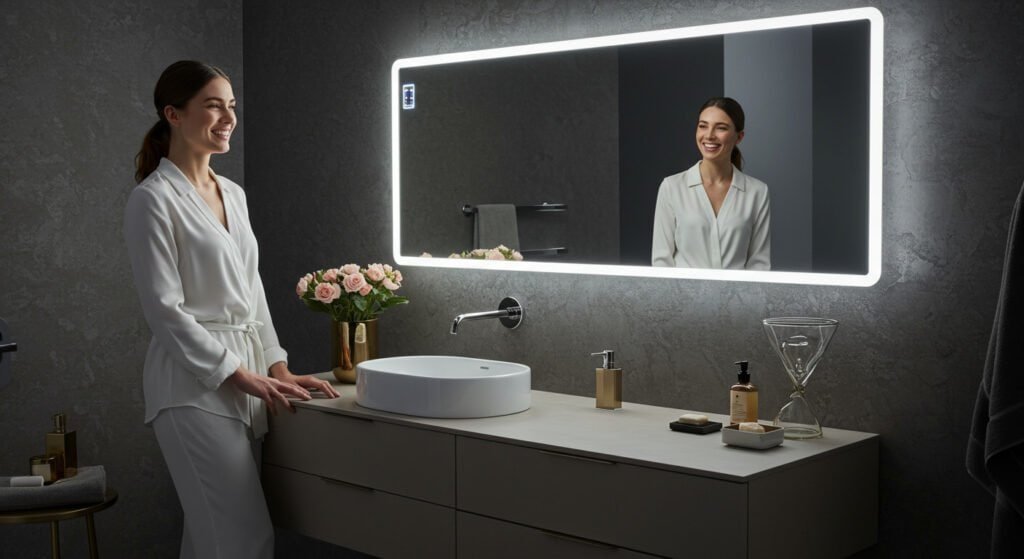|
당신을 얻습니다 트리니티 오디오 플레이어 준비 ...
|
Do you use mirrors daily without understanding their scientific principles? What are mirrors? Most people interact with mirrors constantly yet remain unaware of the sophisticated technology behind modern reflective surfaces.
Mirrors are optical devices consisting of reflective surfaces that produce images through light reflection. Modern mirrors typically feature glass substrates with metallic coatings, creating precise reflections essential for personal grooming, interior design, and scientific applications. Advanced led mirror technology now incorporates intelligent features including adjustable lighting, temperature control, and connectivity options.
Understanding mirror technology enables informed purchasing decisions and optimal space utilization.

What Are Mirrors Made Of?
Mirror construction is accomplished by using advanced materials science that combines optical glass, reflective coatings, and protective layers to provide the best performance and durability.
Glass mirror construction utilizes high-quality glass substrates coated with reflective metallic layers, typically silver or aluminum, sealed with protective backing materials. Premium mirrors incorporate additional coatings for enhanced reflectivity and corrosion resistance.
Modern-day mirror-making uses float glass techniques to create a perfectly flat surface, a requirement for distortion-free reflection. The process for the reflective coating is to deposit silver by chemical reduction, resulting in a uniform metallic film with reflectivity exceeding 95%. A copper layer is then deposited, and paint applied to prevent tarnishing and mechanical damage.
The latest LED bathroom mirror configurations combined these ancient materials with modern electronics, including LED lighting systems, touch controls, and smart connectivity. In the Middle Ages, individuals used polished obsidian mirrors and reflective bronze to look at themselves, showing that our fascination with reflective technology has a lengthy history.
How Do Mirrors Work? (Physics Explained)
The functionality of a mirror is based on basic optical principles governing the behavior of light when it encounters a reflective surface. This behavior then follows predictable image formation based on exact mathematical relationships.
Mirrors operate through specular reflection, where incident light rays reflect at angles equal to their approach angles. This reflection physics principle creates virtual images appearing behind the mirror surface at distances equal to object distances.
The law of reflection is what governs mirrors. It’s the law that says the incident angle equals the reflected angle from the surface normal. This law applies universally to all mirrors, whether simple designs for a bathroom mirror or complex optical systems you might use in a telescope.
Examples of reflection physics can be seen in how a smooth pond or lake will give you a mirror image while a rough body of water will scatter the light and diffuse the reflectivity. Modern lighted vanity mirrors tie all of these together. They give you the benefit of the reflection without sacrificing the quality of the reflection, and you have the luxury of the technology which enhances the visibility. The physics that underlie how mirrors work has a wide variety of applications; everything from simple personal grooming to extremely sophisticated scientific instrumentation uses mirror technology.

What Are Mirrors in Physics and Science?
Mirrors are also used as precision optical instruments for a variety of scientific applications. In these roles, mirrors enable advanced research, measurement, and analysis in fields ranging from astronomy to laser technology to materials science.
In physics and science, mirrors function as essential optical components for directing, focusing, and manipulating electromagnetic radiation. Scientific mirrors achieve exceptional surface quality and reflectivity for research applications requiring precise optical control.
The use of mirrors in scientific optics goes way beyond reflecting light when you shave in the morning. We use mirrors now to steer laser beams, to be the primary and secondary mirrors in telescopes, and to be the heart of extremely sophisticated interferometry systems. The mirror surfaces in research-grade optics have surface roughness measurements in the nanometer range, enabling us to manipulate coherent light to the levels we need for everything from quantum optics to extremely precise measurements.
The same principles are true for products like the backlit mirrors we find in lavish homes and high-tech bathroom designs. You need optical engineering to get light to distribute evenly across the face of the mirror. There’s even a bit of backlit mirror technology using smart mirrors that’s in the marketplace. With a smart mirror, you interact with sensors, displays, and processing all built into the mirror itself.
10 Types of Mirrors You Should Know
There are lots of different types of mirrors such as two-way mirrors, first surface mirrors, and dielectric mirrors to address specific needs or solve unique challenges. People use mirrors in homes, restaurants, hospitals, and office buildings with plenty of creative designs and specific functions.
Essential mirror types include plane mirrors, concave mirrors, convex mirrors, led light mirror vanity designs, bathroom light mirror systems, modern lighted mirrors for bathrooms, smart mirrors, infinity mirrors, dichroic mirrors, and custom architectural mirrors.
| Mirror Type | Key Features | Typical Applications |
|---|---|---|
| Plane Mirror | Standard flat surface, accurate reflection | General use (e.g., bathrooms, 탈의실) |
| Concave Mirror | Curved inward, provides magnification | Makeup application, shaving, medical and dental tools |
| Convex Mirror | Curved outward, wide-angle reflection | Security, traffic surveillance, hallway safety |
| LED Mirror | Integrated LED lights, energy-efficient | Modern bathrooms, hotel rooms, 살롱 |
| Lighted Vanity Mirror | Combines mirror types with adjustable lighting | Makeup stations, professional grooming areas |
| Smart Mirror | Reflective surface + interactive display (시간, 날씨, 등.) | High-end bathrooms, gyms, smart homes |
| Infinity Mirror | Uses parallel mirrors and LEDs to create illusion of infinite depth | Decorative installations, modern interior design |
| Dichroic Mirror | Selectively reflects/transmits specific light wavelengths | Optical devices, lasers, scientific instruments |
| Custom Architectural Mirror | Tailored shapes and sizes to enhance space and light distribution | Interior design, 호텔, commercial buildings |
What Is a Plane Mirror?
The plane mirror is the most common type. It has a flat, reflective surface. When you look in a plane mirror, Reflection you see a virtual image of yourself that maintains all the same proportions and orientation of the actual you.
A plane mirror consists of a flat reflective surface producing virtual images appearing at equal distances behind the mirror. These mirrors create laterally inverted images maintaining original object sizes and proportions.
Probably ninety-nine out of a hundred mirrors in a home or office are plane mirrors. They’re in framed wall mirrors with lights, mirrors over the sinks in the bathroom, large decorative wall mirrors—almost everywhere. A simple, modern lighted vanity mirror for your bathroom uses a plane mirror with integrated LED lighting to give you the best illumination for putting on makeup or shaving.
Rectangular bathroom mirrors are fantastic plane mirrors. They do a wonderful job of giving you a place to mount the lights, hang that decorative mirror with a black frame, and give you all the advantages of a full-sized bathroom mirror while still giving you that full plane mirror experience.

What Is a Concave Mirror?
Concave mirrors have reflective surfaces that curve inward. They are used to focus light and create magnified images. These types of mirrors are frequently used in mirrors for makeup, so you can see much more detail than you could with a flat or slightly curved mirror. Estheticians, cosmetic professionals, or medical professionals use these concave mirrors for doing detailed work right on your face.
Concave mirrors possess curved reflective surfaces that converge light rays to focal points, producing magnified images when objects are positioned within focal lengths. These mirrors enable detailed inspection and precision applications.
When it comes to makeup mirrors, concave mirrors are the name of the game because these mirrors can be used to create magnified images. Think about all of those makeup sticks and wands you see in the store. They use concave mirrors to focus light from the vanity mirror with a light-up system to give you concentrated light where you need it. The professional-grade cosmetic mirrors use concave mirror surfaces to create magnified images. Depending on the radius of curvature and the viewing distance, these mirrors can provide magnification factors from 2x to 15x.
Modern light-up vanity mirrors have regions that contain both concave and plane mirrors. This combination gives you a lot of flexibility in what you can do. We see these mirrors in medical applications, we see them as part of rear-view mirror designs. In industry, you’ll see these kinds of mirrors as part of assembly lines to help with magnified viewing.
Why Do Mirrors Reflect Backwards?
Looking at yourself in a mirror looks kind of weird because the left and right sides appear reversed. This effect is due to how reflections work. Optical physics says that when you look at a reflection in a mirror, your left and right are swapped, but your top and bottom remain in the same position.
Mirrors do not actually reverse images backwards but create lateral inversion where left and right sides appear switched. This occurs because mirrors reflect light directly back along its incident path, creating virtual images.
The feeling that the reflection is backward is entirely due to our brain’s spatial logic because the image is not actually flipped. When you see writing backward in a mirror, it looks that way not because the image is actually backward but because you know from past experience how things are supposed to look.
These general principles of how images form apply to all types of mirrors, from the simplest bathroom vanity mirror up to the most advanced LED mirror designs available. Understanding how images are formed can help you to make the most of your mirror use, especially when it comes to professional applications and precision tasks. Modern backlit mirrors follow these same rules for how images form, but then they super-charge the images with strategic lighting placements.

What Are Mirrors Used For in Modern Applications?
Mirrors in our modern world are used for more than simply reflecting light. They serve myriad functional, aesthetic, and high-tech roles in people’s homes, in the workplace, and in industrial settings.
Modern mirrors serve multiple purposes including personal grooming, interior design enhancement, space optimization, safety applications, and advanced technological integration. Led mirror technology adds intelligent features to traditional reflective functions.
In homes, we use mirrors in our bathrooms to help us get ready in the morning. These high-tech additions to our houses provide more than just a reflection. They light up, provide storage, and feature smart home integration. In businesses, mirrors are used in retail displays, as hospitality amenities, and for architectural embellishments. In industry, mirrors are used in safety systems, quality control processes, and precision optical gear.
LED bathroom mirrors vary lighting conditions for different tasks, and they save energy over time through efficient LED technology. Smart mirror systems include internet connectivity to display information, provide entertainment, and even control the house. Decorative mirrors include infinity mirrors, cool sculptural mirrors, and great design effects using mirrors to manipulate light and space. Security mirrors are mirrors used to control visual angles for surveillance and safety in public areas.
Modern LED Mirror Technology and Features
LED tech in a bathroom mirror can adjust lighting for different tasks. A smart mirror for your bathroom could tie into the internet to display info, provide entertainment, and even help you control your house. Decorative mirrors include infinity mirrors, cool sculptural mirrors, and great design effects using mirrors to manipulate light and space. Security mirrors are mirrors you use to see around corners in public spaces.
Modern led bathroom mirror systems incorporate touch controls, adjustable lighting, defogging capabilities, Bluetooth connectivity, and smart home integration. These features enhance functionality while maintaining superior reflective quality and energy efficiency.
| Feature | Description | User Benefits / Application |
|---|---|---|
| Touch-Sensitive Controls | Enables intuitive control of lighting (brightness, color temperature) | Personalized lighting for grooming, makeup, or ambient use |
| Defogging Function | Built-in heating elements prevent fogging in humid environments | Always clear mirror surface in bathrooms after showers |
| Bluetooth Connectivity | Supports audio streaming and hands-free calls | Enhances user experience during grooming or relaxing routines |
| Smart Home Integration | Compatible with automation systems and voice assistants | Centralized control, voice operation, environment-responsive adjustments |
| Motion Sensors | Automatically activates lighting when motion is detected | Hands-free operation, energy savings, improved nighttime usability |
| Customizable Lighting Zones | Independent control of multiple lighting areas | Optimized illumination for tasks like shaving, skincare, or reading |
| Multifunctional Design | Integrates several features into one smart unit | Space-saving, convenience-focused solution for modern living spaces |

결론
Mirrors have evolved from simple reflective surfaces to sophisticated technological systems that enhance modern living through advanced features, intelligent integration, and superior performance capabilities.
- 올바른 욕실 거울을 선택하는 방법을 알아보려면 여기를 클릭하세요..
- 거울 설치 방법을 알아보려면 여기를 선택하세요..
- 올바른 크기의 거울을 선택하는 방법을 알아보려면 여기를 클릭하세요..
- 거울이 어떻게 만들어지는지 알아보려면 여기를 클릭하세요.
- 여기를 클릭하면 우리가 거울에서 더 잘 보이는 이유를 알 수 있습니다..
- 여기를 클릭하시면 TOP에 대해 알아볼 수 있습니다. 10 LED 거울 제조 업체 2024.
- 화장 거울 표시등이 켜지지 않는 이유를 알아보려면 여기를 클릭하세요.?
- 욕실 거울의 높이는 얼마나 되어야 하는지 알아보세요.? 여기를 클릭하세요
- 거울 청소 방법을 모르신다면 여기를 클릭하세요
- 터치 센서 미러가 작동하지 않는 문제를 해결하는 방법을 알아보려면 여기를 클릭하세요.
- 알아내다 10 일반적인 LED 욕실 거울 문제 여기를 클릭하세요

























